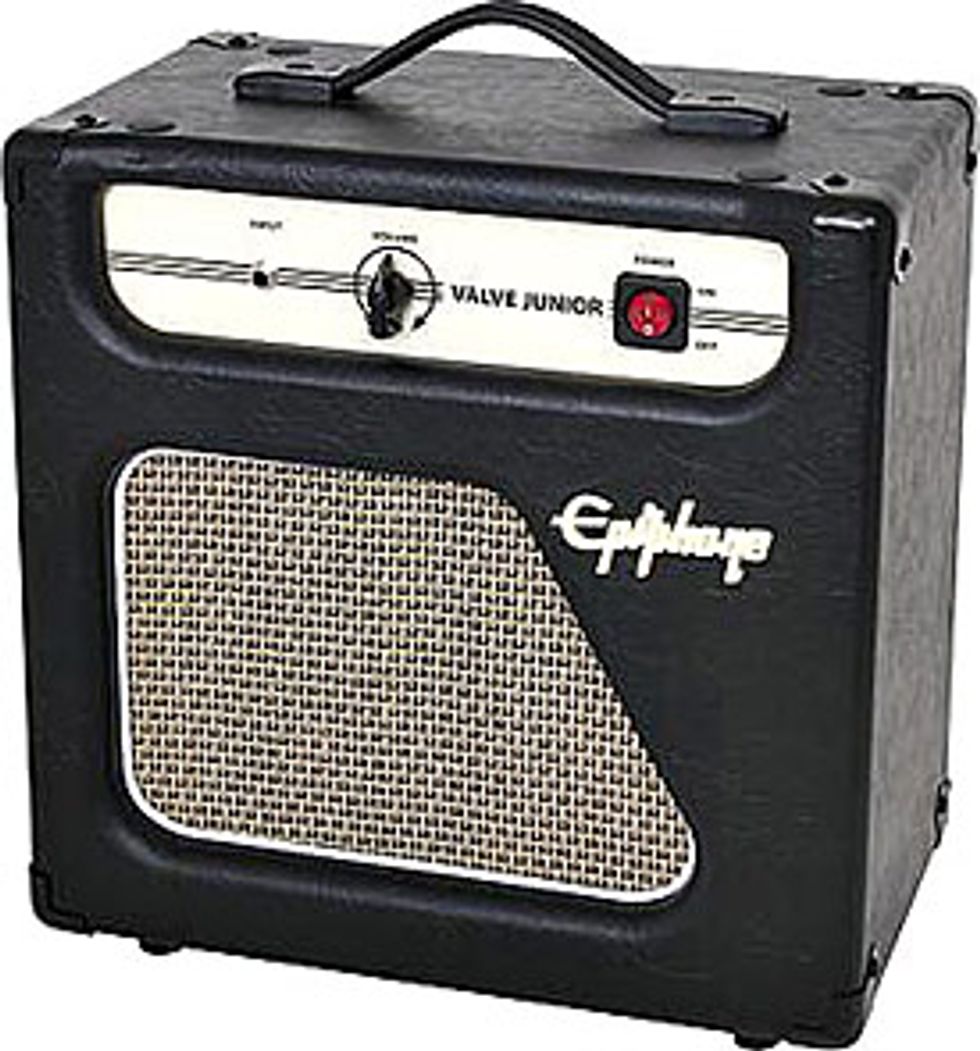
I hope you enjoyed the last column about modding your Telecasters. This month, we''ll talk about a cool-sounding soul mate for your axes.
So you want a small and good sounding all-tube practice/recording amp? And you don''t want to spend a lot of bucks for it? And you''ve always wanted to do some DIY work on a tube amp? Well, here is your ticket.
Since small combos had a real renaissance some years ago, your choices have never been bigger than today. I decided to use the Epiphone Valve Junior, because it has a good overall quality and it''s a real cheapo - you can find it new for around $120 and it''s a real class A tube amp. It produces 5 watts and the cab is loaded with a Weber-designed 8" speaker. Because of its price point, the rest of the amp''s options are as minimal as possible - on/off switch, a volume pot, input jack and speaker out. However, because of the simplicity of the circuit, this little amp is ideal for some beginner modding; you can learn a lot when you spend some time with it.
Today we will talk about some mods for the 2nd generation of this amp, which was sold from approximately March 2006 to today as the combo or the "head only" version. All the mods will also work for the 1st generation of this amp, but they require a lot more work because the circuit suffers from some extra noise and various other unpleasant things. If you have such an amp, check out this website and follow the instructions to quiet the beast.
Before we start, a word of warning and the obligatory liability disclaimer:
Do not attempt to perform these mods if you are not familiar with working inside tube amps or other high voltage electronics. There are lethal voltages inside the amp, even when unplugged (if the filter capacitors have not been discharged) and these voltages can cause serious injury or kill you. If you are unsure, take it to an amp tech.
If you decide to perform these mods, you assume all responsibility for anything that happens! Whether the amp explodes, you get zapped, or the amp suddenly increases in value because everyone falls in love with it, it''s all because of you. The glory, the pain, whatever, they''re all yours. If you can''t live with that, don''t mess with the stuff here.
Okay, with that out of the way, you''ll want to first download the circuit drawing of the amp, print it and put it on your workbench, to follow along with what we''re talking about.
The Epiphone Valve Junior sounds pretty good just the way it is, but there are several things you can do to make it sound even better, run more stable and of course tweak the overall tonal character. I decided to "Fenderize" this amp to make it sound close to an old Fender Tweed Champ. There are plenty more ways to mod it - e.g. to make it sound like a Marshall or like an over the top gain monster, etc. In addition, you can also perform some enhancements like adding a stand-by switch, line-out jack, additional 8-ohm speaker out jack, or implement a tone and gain control, etc.
I will divide all the mods into three categories: general mods, necessary mods and the tone tweaking mods, so you can decide on your own how far you want to go.
I''m sure you all know the famous Fender Tweed Champ - it''s one of the classic little amps that can be heard on countless recordings. It featured a punchy and percussive Fender clean tone and a "true, from the bottom of the heart" overdrive, full and warm sounding - in other words, a tone combination to die for. The Epiphone Valve Junior can be modded in this direction and I had the pleasure to play the modded Epi side by side with an old Fender Tweed Champ - the differences in tone are really minimal. So heat up your soldering irons, unplug the amp, discharge the capacitors and take out the PCB.
| General Modifications |
Tubes
This is a quick, easy, inexpensive and effective way to mod your amp. A simple amp like our Epi with only two tubes gives you the rare ability to really hear the differences between different brands and types of tubes with distinct clarity. For a good Fender tone, pull out the two Sovtek tubes and replace them with a NOS 7025 "black plate" and a good EL84 - I prefer the TAD EL84-STR. Naturally, experiment with different tubes to see what you like best.
Speaker
I really like the stock speaker and it provides a good, punchy tone for its size - it''s a Weber-designed speaker, what else can I say? But if you want to change it, try a Weber 8F125 or any Jensen 8" speaker. I''ve also heard of people squeezing 10" speakers into the combo, but I haven''t seen it yet. Feel free to experiment with any 8" speaker you like; a friend of mine uses an old Peavey "Marvel" speaker in this amp and it sounds fantastic.
Output Transformer
Many of the less-expensive amps available today ship with low-budget output transformers. These are designed to be cheaply made and sound quality can suffer in many cases. Inexplicably, the Valve Junior OT is wound with a 7.5K primary, when the ideal primary for an EL84 in SE mode is 5.2K. I did not change my OT because I like the sound the way it is, but if you want to replace it, try a Hammond 125CSE, which is twice the mass of the stock OT and can be wired for an almost-ideal 5K primary impedance. There are some more OTs that will fit your needs, so feel free to use a different brand.
| Necessary Modifications |
The mods discussed here should be done to any Epiphone amp to extend tube life and to make it run much more stable and quiet!
- Connect a 20 ohm/20-watt power resistor between the IEC mains input socket and one of the primaries of the power transformer. This will bring the plate voltage down to approximately 300VDC and will extend tube life dramatically.
- Replace R14 (stock value: 220 ohm) with a 270 ohm/5-watt resistor for true class A performance and extended tube life.
- Replace C6 (stock value: 22uF) with a 120uF/450-volt electrolytic capacitor to quiet the amp by providing a better filtering of the power supply.
- Replace the four 1N4007 diodes with UF4007 to get rid of this switching noise.
- If you have an amp with a non-insulated input jack, replace it with a nylon input jack to break the ground loop and get rid of the 60 Hz hum.
- Replace the speaker cable with a good quality speaker cable with a slightly heavier gauge and solder it to a heavy-duty Switchcraft "angled" plug.
| Tone Tweaking Mods |
This is the section where you can influence your tone and tweak it in any direction you want. Let''s dig deep into the ''50s and make this Chinese Epiphone amplifier sound like it''s famous Californian model.
- Replace the stock 1M volume pot with a CTS 500K audio taper pot.
- Solder a 47pF silver mica cap across the right and middle lugs of the new volume pot.
- Replace C1 and C2 with 0.022uF Sprague 715 Orange Drop caps.
- Change R8 and R9 to 1.5k carbon film resistors.
- Change R1 to a 1M metal film resistor.
- Jumper R2.
- Change C5 to a 470uF/25-volt electrolytic cap.
- Change R4 to a 100k carbon comp resistor.
The sum of all these mods will give you an incredibly authentic-sounding Fender tone and a one-of-a-kind practice/recording amp. And believe me - nothing beats the feeling of playing a top-notch sounding amp you have modded yourself!
I hope you enjoyed this one. Happy soldering, God bless and greetings from good old Germany - see ya all next month!
Dirk Wacker has been addicted to all kinds of guitars since the age of 5 and is fascinated by anything that has something to do with old Fender guitars and amps. He hates short scales and Telecaster neck pickups, but loves twang. In his spare time he plays country, rockabilly, surf and Nashville styles in several bands, works as a studio musician and writes for several guitar mags. He is also a hardcore DIY guy for guitars, amps and stompboxes and also runs an extensive webpage (singlecoil.com) about these things.







![Rig Rundown: Russian Circles’ Mike Sullivan [2025]](https://www.premierguitar.com/media-library/youtube.jpg?id=62303631&width=1245&height=700&quality=70&coordinates=0%2C0%2C0%2C0)


























